Staffing, budgets, geographic considerations, and departmental tactical preferences are all reasons fire departments give for their choice of rescue truck size, from twin-rear axle behemoths to midsize rigs and pickup truck size rescues.
Mark Brenneman, assistant sales manager for 4 Guys Fire Trucks, says his company has been operating on producing the large size rescue trucks because that’s the size his customers are spec’ing. He notes 4 Guys recently built a walk-in rescue for the Maugansville Goodwill (MD) Volunteer Fire Company on a Mack Granite tandem rear axle chassis powered by a 380-horsepower (hp) Cummins L9 diesel engine and an Allison 3000 EVS automatic transmission with a 30-kW Onan power takeoff (PTO) generator, a Will-Burt Night Scan PowerLite light tower, high angle rescue tie-off points on the body, winch receivers on each side of the body, and automatic snow chains for the rear tires.
- Specialty Rescue Trucks and Trailers Equip Fire Department Fleets
- Dollars and Sense: Rescue Truck Options
- Technical Rescue Trucks and Trailers
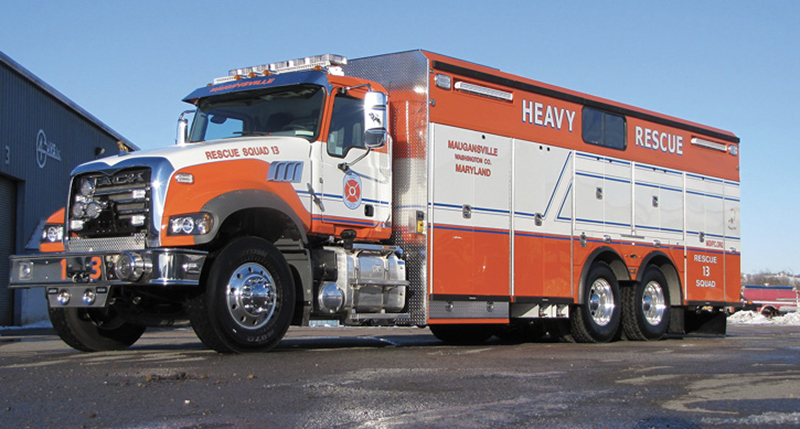
1 4 Guys Fire Trucks built this walk-in heavy rescue on a Mack Granite tandem rear axle chassis for the Maugansville Goodwill (MD) Fire Department. (Photos 1-2 courtesy of 4 Guys Fire Trucks.)
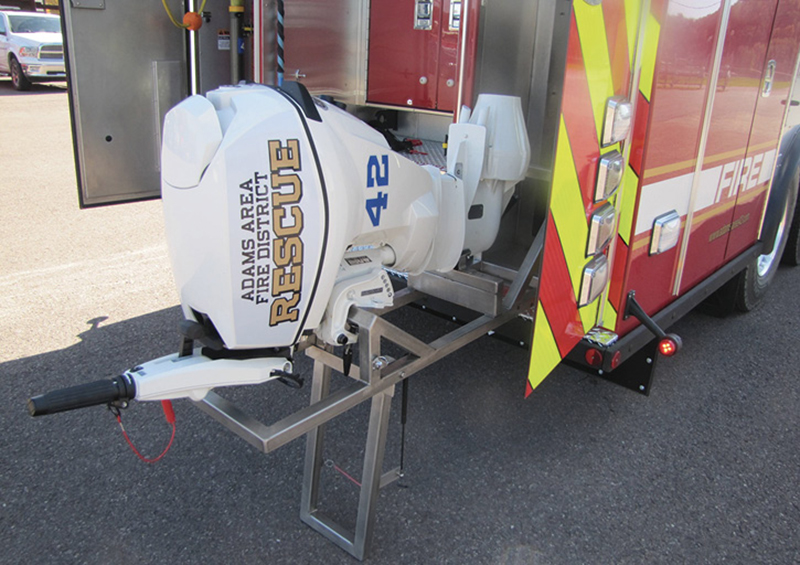
2 The walk-in heavy rescue that 4 Guys built for the Adams Area (PA) Fire District has a storage compartment at the rear that holds an outboard motor the department uses to power its rigid-hull inflatable boat.
For the Northfield (CT) Volunteer Fire Company, 4 Guys built a heavy rescue on a Spartan Metro Star LFD chassis and cab with a 10-inch raised roof on a single rear axle. Brenneman notes the rescue has a walk-around body with a 25-kW Onan PTO generator, an emergency medical services (EMS) compartment in the cab, roll-up doors over compartments, a rear traffic control light, and two electric rewind reels of 250 feet of 10/3 electric cord each.
Bill Proft, business unit manager of rescue products for Pierce Manufacturing Inc., says over the past year Pierce has been building rescues large, small, and in between. “But there’s a decided slant toward larger rescues and over the last couple of years we are seeing more tandem axle, two-door cab, walk-in units being built,” Proft observes. “Many of these trucks are going to the Northeast, likely because that is a traditional rescue squad style for that region.”
Proft notes that in the past year Pierce has built a number of walk-around rescues with pumps and water tanks on them. “These wet rescues will carry anything from our PUC pump to a small 500-gallon per minute (gpm) shaft-driven pump with a 300-gallon water tank,” he says. The smaller rescues that Pierce has been building, Proft adds, “are usually on commercial chassis, single-axle vehicles with three compartments on each side and are typically used to carry breathing air systems and light towers.”
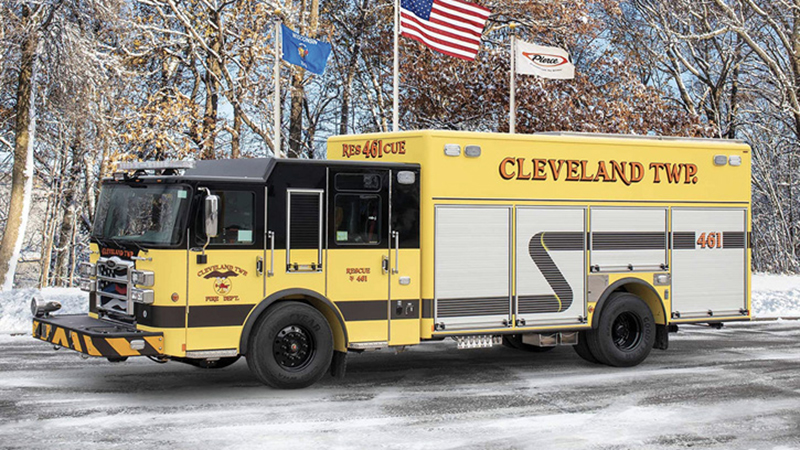
3 Pierce Manufacturing Inc. built this walk-around heavy rescue truck that carries a pump and water tank for the Cleveland Township (IN) Fire Department. (Photos 3-4 courtesy of Pierce Manufacturing Inc.)

4 The Norman (OK) Fire Department had Pierce Manufacturing build its air and light rescue truck on a medium duty chassis.
Tony Klanderud, apparatus program manager for Rosenbauer America LLC, says Rosenbauer has been building a wide range of rescues but mostly heavy units on tandem rear axles. “The majority of them have large bodies with staircases to walkways on top of the rig,” Klanderud says. “We’ve also done a lot of them that double as hazardous materials trucks with slide-outs and command centers inside. A lot of the heavy rescues fire departments want carry all their rescue tools for auto extrication, technical rope rescue, struts and trench rescue equipment for collapse incidents, cascade systems, air tools and compressors, three phase generators, and even rescue boats.”

5 Rosenbauer built this heavy rescue on a tandem rear axle chassis for the Provo (UT) Fire Department. (Photos 5-6 courtesy of Rosenbauer.)
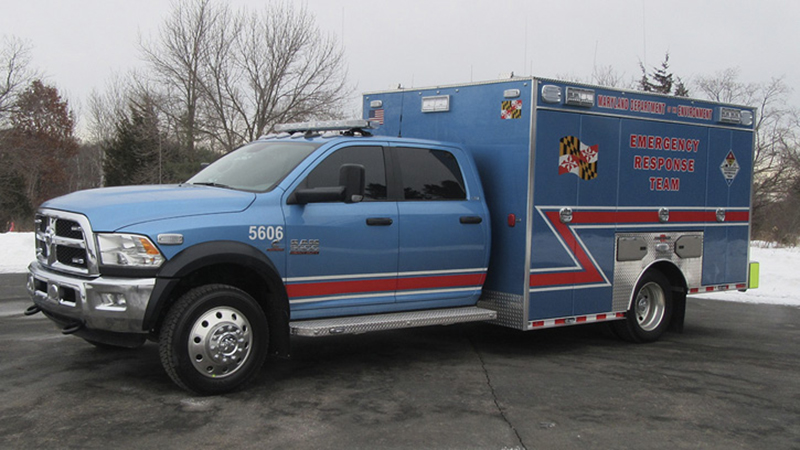
6 The Maryland Department of the Environment had Rosenbauer build this small rescue on a Dodge Ram 5500 chassis.
He points out that the mid-size rescues Rosenbauer has built are typically on a single rear axle and carry a cascade system; hydraulic rescue tools; and, in some cases, a pump and water tank. “The smaller units might carry a two-bottle cascade system, battery-powered hydraulic spreader and cutter, and maybe a Rosenbauer UHP (ultra-high pressure) pumping unit,” Klanderud points out. “With the UHP on it, the vehicle can operate as a quick attack unit as well as a rescue.”
Unruh Fire is a big proponent of the smaller-sized rescues, says Todd Nix, Unruh’s apparatus consultant. “Most of the rescues we are building are on the Ford F-550 and Dodge 5500 chassis,” Nix says, “and the smallest we’ve ever built was on a Chevy 3500 chassis with an 8-foot body. Then there are the customers who are looking for a medium-duty rescue, which we usually will put on a Freightliner M2 chassis with a 16-foot body, unless the department requires something else.”

7 Unruh Fire built this medium duty rescue on a Ford F-550 chassis for the New Martinsville (WV) Fire Department with plenty of slide-out trays and tool boards as well as coffin compartments on top. (Photo 7 courtesy of Unruh Fire.)
Dwayne Woodard, regional sales manager for SVI Trucks, says lately SVI has seen an even 50/50 split between orders for large and small rescues. “This past year, we have built almost no medium rescues,” Woodard says. “We’re seeing a lot of departments scaling back to a dedicated small rescue that they can run along with a pumper, which is something popular with volunteer fire departments. We recently built three light rescue units for the Midland (TX) Fire Department on Ford F-550 super cabs and chassis with 9-foot rescue bodies.”
But there’s still a strong demand for large rescues, Woodard maintains. “We are building five rescues for the Columbus (OH) Fire Department, where two of them have the front compartment area of the body behind the cab as a walk-in area where the Columbus water rescue crews can work and gear up,” he says. “We recently built a walk-in heavy rescue for the Earleigh Heights (MD) Fire Department on a Seagrave chassis and two-door cab that is set up to carry six firefighters. And we have three rescue trucks on order that carry 300 to 500 gallons of water, one of them with a 1,000-gpm pump under the frame rails.”
Brad Turk, regional sales manager for Rescue 1, says, “Over the past year and a half, smaller rescue trucks have become more popular. Departments are choosing Ford F-550 and Chevy Silverado 650 chassis and four-door cabs with a 12-foot body.” Turk notes that if a fire department can afford a heavy rescue, it usually will choose a 22- to 24-foot body rig that can carry a lot of equipment and personnel.
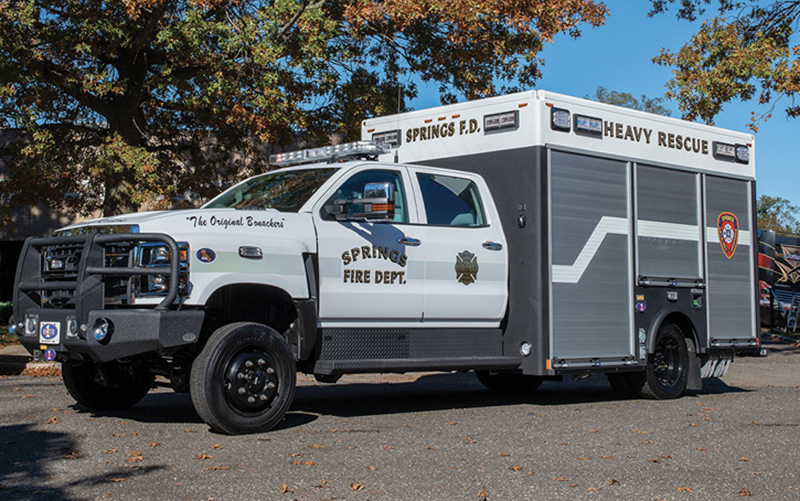
8 Rescue 1 built this light duty rescue truck on a Chevrolet Silverado 6500 chassis for the Springs (NY) Fire Department. (Photo 8 courtesy of Rescue 1.)
“We’ve also built rescues on the International CR chassis that have a GVWR (gross vehicle weight rating) of 23,500 pounds, which allows the department to put more equipment on it than a 19,500-pound GVWR chassis,” Turk says. He notes that Rescue 1 also has built medium rescues on Freightliner M2 and International 4900 chassis, usually with a 22-foot body on a single rear axle. “We are seeing a trend of walk-in rescues making a comeback,” he notes. “Some departments like to have a rescue with a half-walk-in at the front of the body and the rest of the truck as a walk-around,” he adds. “We call that a combination rescue and we can do that on a single rear axle.”
Joe Messmer, president of Summit Fire Apparatus, says Summit has been building a number of single rear axle walk-around rescues, usually for smaller volunteer fire departments, as well as rescue-pumpers and a smattering of mini-rescues on Ford F-550 chassis. “The biggest change in rescues is they are leaving generators off of them,” Messmer says. “With all LED scene lights and light towers running off of 12-volt systems and rescue tools being battery powered, they often don’t need the generators onboard anymore.”
Alex Hobday, sales engineer for Spencer Manufacturing Inc., says Spencer has been building a lot of smaller rescues, mainly for rural and volunteer fire departments. “These are usually on a Ford F-550 chassis and some with a 14-foot body as well as on medium commercial chassis like the International and Freightliner,” Hobday says. He notes Spencer recently built a small rescue for the Melrose Township (MI) Fire and Rescue on a Ford F-550 4×4 chassis and cab with a 10-foot walk-around rescue body, carrying an air cascade system, light tower, and generator.
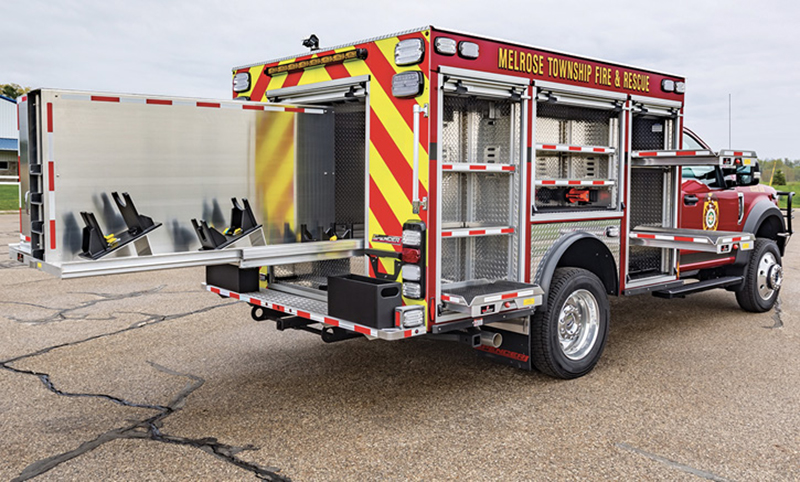
9 Spencer Manufacturing Inc. built this light rescue on a Ford F-550 4×4 chassis with a 10-foot walk-around body for the Melrose Township (MI) Fire and Rescue. (Photo 9 courtesy of Spencer Manufacturing Inc.)
For the Martin Township (MI) Fire & Rescue, Hobday notes, Spencer built a rescue on a Spartan Metro star ELFD chassis and cab with 20-inch raised roof, 18-foot walk-around body, full transverse compartments, light tower, generator, and coffin compartments on top. For the South Haven Area (MI) Emergency Services, Spencer built a rescue on a Spartan chassis with an 18-foot split walk-in and walk-around body, four seats in the walk-in section, carrying a cascade system, light tower, and generator.
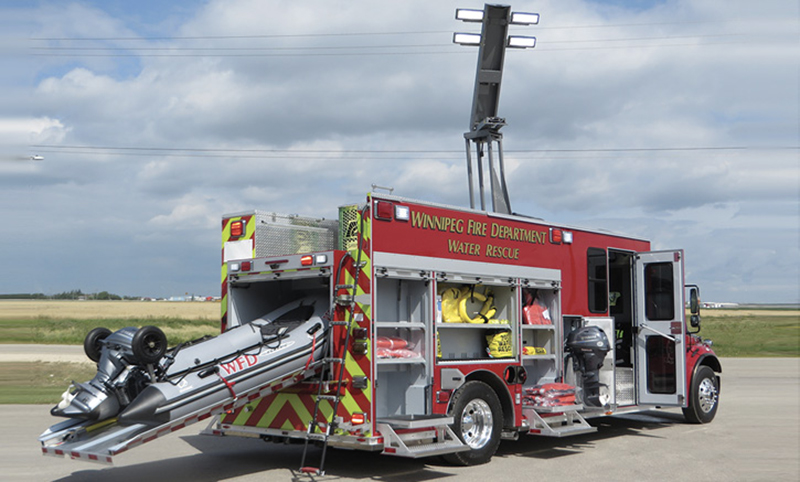
10 The Winnipeg (Manitoba) Fire Department chose Fort Garry Fire Trucks to build this medium duty water rescue truck. (Photo 10 courtesy of Fort Garry Fire Trucks.)
Robert Pike, corporate services manager for Fort Garry Fire Trucks, says his company is still seeing a mix of sizes of rescue trucks. “We see a lot of the lighter rescues, especially with those fire departments that are running medical calls,” Pike says. “Usually, they are set up for a two-person crew on a chassis like a Ford F-550 and carry basic light rescue equipment, along with patient care equipment.” Pike adds, “The heavier units are still out there with the equipment they need to carry, whether it be hydraulic tools for motor vehicle accidents or confined space or trench rescue equipment. With some of the medium duty rescues, we’re seeing fire departments use them as a rest and rehab unit where the area behind the cab allows the crew to get out of the elements while working at a scene.”
ALAN M. PETRILLO is a Tucson, Arizona-based journalist, the author of three novels and five nonfiction books, and a member of the Fire Apparatus & Emergency Equipment Editorial Advisory Board. He served 22 years with the Verdoy (NY) Fire Department, including in the position of chief.

